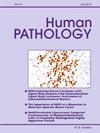未分化胚胎性肝肉瘤:来自同一机构的10例临床病理和基因组研究。
IF 2.6
2区 医学
Q2 PATHOLOGY
引用次数: 0
摘要
目的:未分化胚胎性肝肉瘤(UESL)是一种罕见的侵袭性恶性肿瘤,临床病理和基因组特征有限。本研究旨在调查一组UESL病例的基因组异常。方法:对2018 - 2025年我院确诊的10例UESL病例进行分析。肿瘤标本使用OncoKids®面板进行基于DNA和rna的下一代测序,并进行染色体微阵列分析。结果:中位诊断年龄13.0岁(范围0.8 ~ 18.3),中位肿瘤大小14.4 cm(范围7.5 ~ 26.0)。3例患者出现肺转移,6例肿瘤出现囊破裂。组织学显示多形性,深染的卵形,梭形或星状细胞,CD56阳性。TP53是唯一的复发性突变基因,在10个病例中有9个被发现。双等位基因TP53失活(突变加上拷贝数丢失,n = 7)与单等位基因TP53突变(n = 2)相比,染色体复杂性更高。仅在双等位基因TP53失活的肿瘤中观察到19q13.42-q13.43,包括19号染色体microRNA簇(C19MC)的片段性增加。未检测到有临床意义的RNA融合。所有患者均行肿瘤切除术和基于arst0332的化疗;6例肿瘤破裂患者中有4例也接受了全腹放射治疗。中位随访32.0个月(范围:3.0 - 81.2),9例患者均存活。结论:TP53突变是UESL的一个决定性分子事件,双等位基因失活与染色体复杂性增加和C19MC位点增加有关。尽管其具有侵袭性,但多模式治疗仍可获得良好的结果。本文章由计算机程序翻译,如有差异,请以英文原文为准。

Undifferentiated embryonal sarcoma of the liver: A clinicopathological and genomic study of 10 cases from a single institution
Aims
Undifferentiated embryonal sarcoma of the liver (UESL) is a rare and aggressive malignancy with limited clinicopathological and genomic characterization. This study aimed to investigate the genomic abnormalities in a cohort of UESL cases.
Methods
We analyzed ten UESL cases diagnosed at our institution from 2018 to 2025. Tumor specimens underwent DNA and RNA-based next-generation sequencing using the OncoKids® panel, along with chromosomal microarray analysis.
Results
The median age at diagnosis was 13.0 years (range: 0.8–18.3), and the median tumor size was 14.4 cm (range: 7.5–26.0). Lung metastases were present in three patients, and six tumors exhibited capsule rupture. Histology revealed pleomorphic, hyperchromatic oval, spindle, or stellate-shaped cells, with CD56 positivity. TP53 was the sole recurring mutated gene, identified in nine of ten cases. Biallelic TP53 inactivation (mutation plus copy number loss, n = 7) correlated with greater chromosomal complexity compared to monoallelic TP53 mutations (n = 2). Segmental gain at 19q13.42-q13.43, including chromosome 19 microRNA cluster (C19MC), was observed only in tumors with biallelic TP53 inactivation. No clinically significant RNA fusions were detected. All patients underwent tumor resection and ARST0332-based chemotherapy; four of six patients with tumor rupture also received whole abdominal radiation. At a median follow-up of 32.0 months (range: 3.0–81.2), all nine patients with follow-up were alive.
Conclusions
TP53 mutation is a defining molecular event in UESL, with biallelic inactivation linked to increased chromosomal complexity and C19MC locus gain. Despite its aggressive nature, favorable outcomes are achievable with multimodal therapy.
求助全文
通过发布文献求助,成功后即可免费获取论文全文。
去求助
来源期刊

Human pathology
医学-病理学
CiteScore
5.30
自引率
6.10%
发文量
206
审稿时长
21 days
期刊介绍:
Human Pathology is designed to bring information of clinicopathologic significance to human disease to the laboratory and clinical physician. It presents information drawn from morphologic and clinical laboratory studies with direct relevance to the understanding of human diseases. Papers published concern morphologic and clinicopathologic observations, reviews of diseases, analyses of problems in pathology, significant collections of case material and advances in concepts or techniques of value in the analysis and diagnosis of disease. Theoretical and experimental pathology and molecular biology pertinent to human disease are included. This critical journal is well illustrated with exceptional reproductions of photomicrographs and microscopic anatomy.
 求助内容:
求助内容: 应助结果提醒方式:
应助结果提醒方式:


